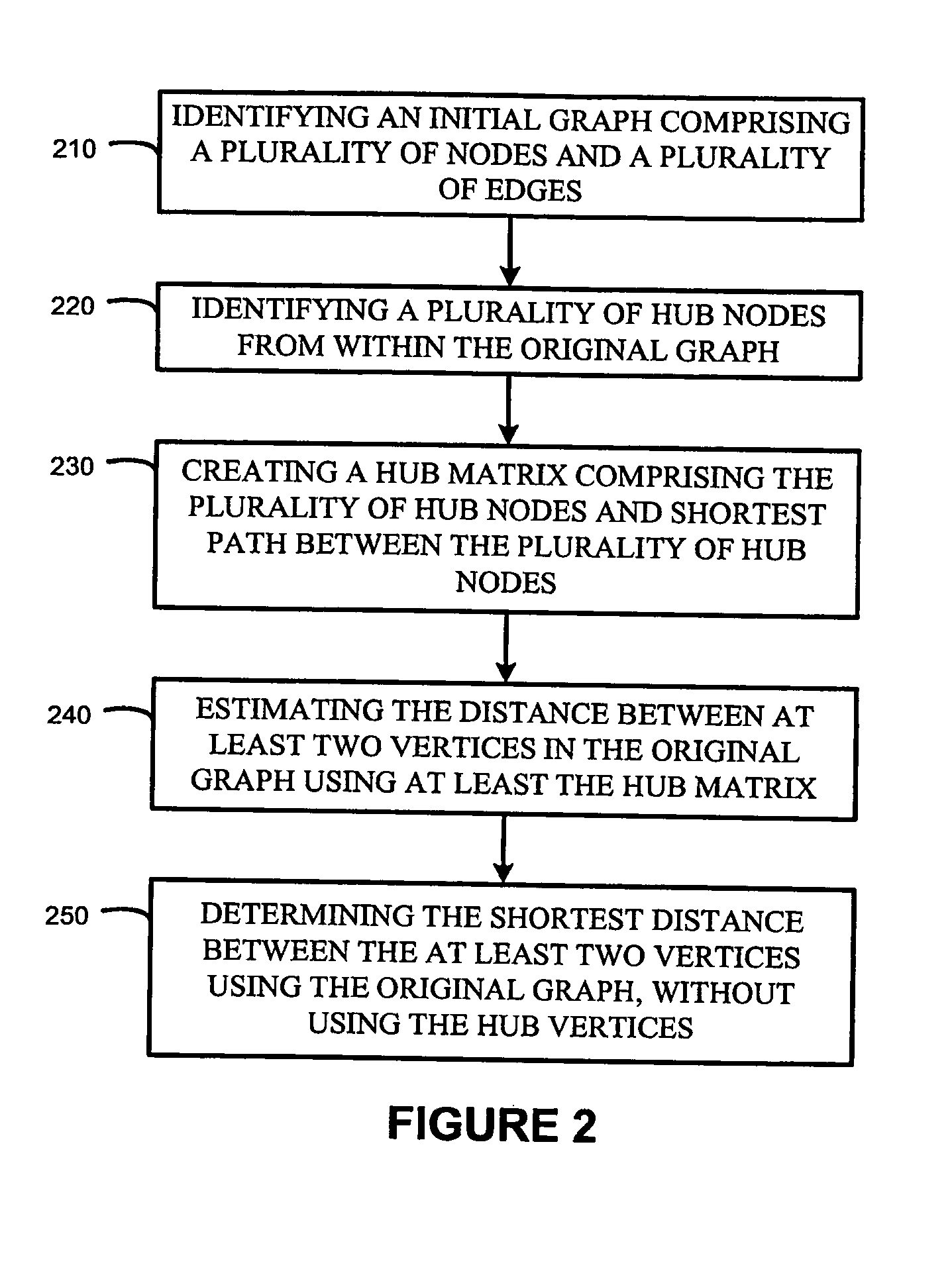Shortest path computation in large networks
a technology of shortest path and computation method, applied in the field of shortest path computation in large networks, can solve the problems of social networks with millions of vertices, prohibitively expensive application of these methods, explosion of search space,
- Summary
- Abstract
- Description
- Claims
- Application Information
AI Technical Summary
Benefits of technology
Problems solved by technology
Method used
Image
Examples
example 4.1
[0092]FIG. 4 shows the network and will used as a running example. FIG. 5 is the corresponding hub-network with H={4, 6, 8, 12, 17, 18, 19} (degree ≧5) when k=4. Since the pairwise distances between these hubs are all less than 4, D4 contains all the hub pairs with a total of 15 vertex pairs.
[0093]Note that an alternative approach is to build the weighted hub-network which explicitly connects the hub pairs: for instance, if any other hub lies in a shortest path between two hubs, an edge can be added to directly link them. Indeed, most of the existing studies have adopted a similar approach to build and utilize some highway structure (but targeted mainly road networks, which are rather sparse). However, this approach can lead to a number of problems when searching a massive social network: 1) Such hub-network would be weighted and could be dense (many new edges may need to be added between hubs) and to search through it, Dijkstra's algorithm (or its variant) must be utilized and woul...
example 4.2
[0115]FIGS. 8 and 9 illustrate the incremental maintenance of flag b and score fin the BFS process. Here the vertices h, 2, 4, 9, and 11 are hubs. In FIGS. 8 and 9 (a), (h, 2), (h, 4), and (h, 11) are basic pairs; the flag b changes from b=1 originally to b=0 (Lines 5-7). After the flag b of 2, 4, and 11 changes to false (b=0), all their descendents in the BFS traversal become false. For instance, the flag b of vertex 5 is false as it is also considered hub 2's descendent. In FIG. 9, the shaded vertex 3 indicates it is already included in the hub-network (3εH*). Therefore, vertex 11 points to vertex 8 (parent(11)=8 and parent(8)=3) as its f score is higher than that of vertex 6.
[0116]Theorem 2.
[0117]If Algorithm 1 is invoked for each hεH, then the induced subgraph G[H*] is a hub-network of H with respect to the k-degree shortest path.
[0118]Proof Sketch:
[0119]The correctness of the algorithm can be derived from the following two observations: 1) for any basic pair (h, u) with distanc...
example 6.1
[0170]FIG. 6 illustrates the core-hubs (along with the distance) for each non-hub vertices in the original graph (FIG. 4). Here the hubs are 4, 6, 8, 12, 17, 18, and 19. For instance, Vertex 1 only needs to record core-hubs 4, 6, 12 and 19, and it can reach hubs 8 and 17 through them in some shortest path.
[0171]Using the core-hubs L and distance-matrix Hub2, the distance and the shortest path for vertex pair (s, t) can be approximated in the following fashion:
dH(s,t)=minxεL(a)yεL(t){d(s,x)+d(x,y)+d(y,t)} (2)
Here, d(x, y) is the exact distance recorded in the distance-matrix Hub2.
[0172]The construction of the distance matrix Hub2 and the labeling of core-hubs are also rather straightforward. The BFS procedure in Algorithm 1 can be easily adopted:
1) each BFS performs k steps and thus the distance matrix can be directly constructed;
2) when a vertex v has flag b=1 (basic pair) from BFS traversal of h, h is appended to L(v). Thus, the total computational complexity of the pre-computatio...
PUM
 Login to View More
Login to View More Abstract
Description
Claims
Application Information
 Login to View More
Login to View More - R&D
- Intellectual Property
- Life Sciences
- Materials
- Tech Scout
- Unparalleled Data Quality
- Higher Quality Content
- 60% Fewer Hallucinations
Browse by: Latest US Patents, China's latest patents, Technical Efficacy Thesaurus, Application Domain, Technology Topic, Popular Technical Reports.
© 2025 PatSnap. All rights reserved.Legal|Privacy policy|Modern Slavery Act Transparency Statement|Sitemap|About US| Contact US: help@patsnap.com



